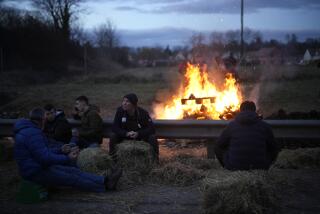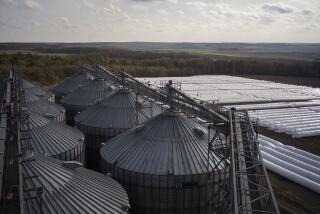COLUMN ONE : Reaping a Peck of Trouble : The Soviet Union’s unexpected bumper crop of grain has turned into too much of a good thing. A lack of rail cars and storage facilities may mean more food shortages.
- Share via
KRASNODAR, Soviet Union — The squinting, weathered watchman at the Korenovsk Elite-Seed State Farm surveyed the small mountains of grain surrounding him, spilling along the pavement under the beating sun, and shrugged.
“Yes, the bread is good this year,” Nikolai Govorushenko said. “But there’s nowhere to send it. The elevator won’t take it, the storehouses won’t take it.
“May God hold back the rain.”
Soviet farmers are blessed with one of the best harvests in memory this year--260 million tons of grain, according to preliminary government estimates--but the country’s storage and transportation network cannot cope with the unexpected bumper crop.
And despite the summer’s bounty, the Soviet Union again faces the prospect of worsening food shortages this winter.
The probable loss of up to one-third of the harvest--the difference between the country being able to feed itself or being forced to turn to expensive imports--has prompted a desperate scramble among local and national leaders to get the crops in as soon as possible.
Boris N. Yeltsin, the radical president of the Russian Republic, issued an anything-goes appeal to citizens to do whatever it takes to bring in the harvest, promising that all those who help will receive special coupons allowing them to buy scarce consumer goods.
In Yaroslavl, 150 miles northeast of Moscow, authorities imposed a local state of emergency and vowed to get the harvest in even if it meant marshaling industrial workers, students and army units.
By government count, only 150,000 urban residents are helping gather the harvest this year, compared to 700,000 in past years.
Soviet Prime Minister Nikolai I. Ryzhkov announced that the country would hold back oil it had planned to export, largely to Eastern Europe, and reallocate it to harvest areas suffering from drastic fuel shortages.
Earlier this month, he said the government planned to send 10% to 15% of all vehicles belonging to the country’s enterprises to help with the harvest and to put police, KGB and Defense Ministry personnel on the job as well.
The country must make the harvest a success, Ryzhkov has warned on national television, because it cannot afford to keep importing tens of millions of tons of grain each year.
Last year, the Soviet Union spent sorely needed hard currency to import 44 million tons of grain, but the government has warned that it does not have the cash to buy the same amount this year. Soviet officials have requested $2 billion in credits from the United States to buy American grain.
“If we do not cardinally change the situation,” Ryzhkov told a meeting of the government’s top advisory councils last month, “the country will be in no condition--and I state this responsibly--to import grain in such quantities.”
In Krasnodar, a province in the northern Caucasus Mountains often likened to California for its natural riches and superb climate, railroad workers washed out more than 100 cars meant for carrying concrete, dried them and loaded them with grain instead. At the seed processing center of the Kolos experimental farm a few miles away, a garage was turned into a temporary granary.
“More grain, more problems,” said Alla V. Kubakhova, the center’s agronomist. “There’s just nowhere to put it.”
Mostly, though, the tons upon tons of tawny grain lie out in giant mounds until trucks can be found to take them to local elevators and trains can be found to move them out.
“If there’s one rain, it will start to rot, and if there are two rains about three days apart, that’s it,” said Govorushenko, the watchman at the Elite-Seed State Farm.
Two million tons of grain is being lost each day because it is not gathered and stored fast enough, according to the Soviet Council of Ministers.
Russia exported grain before the 1917 Bolshevik Revolution. But since Josef Stalin eliminated private farms in his 1929-1930 collectivization of agriculture and replaced them with large collective and state farms, the country has had to struggle to feed itself.
President Mikhail S. Gorbachev has introduced a series of increasingly radical agricultural reforms aimed at making farmers work better by giving them the feeling that the land once again belongs to them and they will profit personally from bigger harvests.
But food supplies have dwindled further, discrediting his policies and costing him more popular support than any other aspect of perestroika, his reform program.
If the government cannot buy enough grain from the country’s farmers and refuses to spend more hard currency on imports, there are dire predictions that there might even be shortages of bread, the staple of the Soviet diet.
But an imminent catastrophe was hard to discern amid the towering sunflowers, flourishing beet greens and straight-standing corn in Krasnodar. With the peak of the grain harvest just past, the picture was one of widespread abundance, and officials here said Gorbachev’s reforms were finally starting to work.
Nikolai I. Kondratenko, the head of the provincial administration in Krasnodar, said that in addition to perfect weather, the boom harvest reflected improved technology learned from the West over the past few years and the farmers’ new feeling of being “masters of the land.”
The reforms have given farmers more control over their own fields but failed to solve the problem of how to get the increased produce to Soviet consumers.
Farmers are now allowed to sign contracts themselves with produce-buyers instead of working through centralized ministries, but many of the contracts do not deal with transport and storage, according to Yuli N. Semenenko, the Krasnodar correspondent for the farming newspaper Village Life.
Similarly, Semenenko said, the centralized planning system is breaking down, new direct market links are only now being formed and rail traffic, the Soviet Union’s main means of transporting goods, is growing increasingly snarled.
The general disorganization turned into crisis in the last week of July when partisans in the nearby Caucasus republic of Georgia blocked rail traffic in a political protest, paralyzing most of Krasnodar’s rail lines for days and putting the grain in danger of further spoilage. They lifted their blockade on Aug. 1.
The region, known as the Kuban, also suffers from train shortages because cars that go into the restive Caucasus republics of Armenia, Azerbaijan and Georgia sometimes fail to return, and those that carry grain to the far reaches of Russia sometimes take weeks to get back.
In general, the Kuban, some of the Soviet Union’s richest agricultural land, got only about half the rail cars it needed during much of the harvest, according to the government newspaper Izvestia.
Inside the marble-fronted administration building of the Krasnodar regional railroad, in the anteroom of the acting chief of operations, occasional shouting could be heard through the thick door.
“It’s been standing idle for four days!” was one audible fragment.
Arkady D. Tolstobrov, neat in a blue railroad uniform when he emerged from his office but also apparently exhausted by the long hours, said there is increased pressure on railroad workers to free grain cars for the new crop of sunflowers, a major source of cooking oil.
“The demand for cars is growing,” he said. “The problem is, we’re supplying all of Russia--it all wants to try our Krasnodar grain.
“There’s no time for sleep now. The main thing is to get out this grain. Nothing else matters.”
Trucks cannot help solve the problem because there are too few of them and gasoline is severely depleted as well, with many drivers waiting two or three hours in line to fill their tanks.
Russian country roads are also notoriously poor, many still unpaved or with giant, axle-bending potholes, while most rail lines are at least adequately maintained.
At a railside elevator just outside the city of Krasnodar, a scale operator said tension was so high that drivers of grain-laden trucks had begun fighting over whose turn was next.
“And myself, I didn’t even have time to go to the bathroom,” the operator said, plucking black seeds from a sunflower head and chewing on them.
Added enthusiasm on the farm is also not enough to offset deep-seated supply problems that leave combines and other harvesting equipment rusting in the fields for lack of spare parts. Out of 700,000 combines in the country, 107,000 were not ready for this year’s harvest, according to government statistics.
Govorushenko pointed out two large pieces of the Elite-Seed farm’s machinery left rusting out in the sun. They cost thousands upon thousands of rubles, he said, but seemed to be good for nothing. “They spend money on machinery instead of the workers,” he complained.
One more complication for the overloaded grain storage system arose in the final days of July with the arrival in Black Sea ports of shiploads of imported American grains, ordered before the bumper harvest was assured. The expensive imported grain thus took storage space away from Soviet grain, national television reported.
Perhaps one day, the Soviet television reporter added, those seaside elevators will once again be used for exporting Soviet grain instead of holding grain bought overseas.
More to Read
Sign up for Essential California
The most important California stories and recommendations in your inbox every morning.
You may occasionally receive promotional content from the Los Angeles Times.













